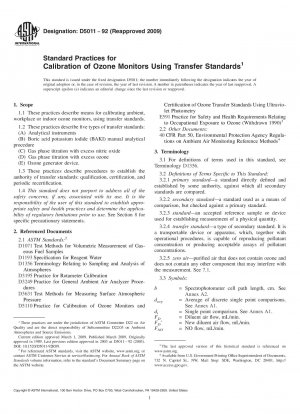ASTM D5011-92(2009)
Standard Practices for Calibration of Ozone Monitors Using Transfer Standards
- Standard No.
- ASTM D5011-92(2009)
- Release Date
- 1992
- Published By
- American Society for Testing and Materials (ASTM)
- Status
- Replace By
- ASTM D5011-17
- Latest
- ASTM D5011-17
- Scope
The reactivity and instability of O3 precludes the storage of O3 concentration standards for any practical length of time, and precludes direct certification of O3 concentrations as SRM''s. Moreover, there is no available SRM that can be readily and directly adapted to the generation of O3 standards analogous to permeation devices and standard gas cylinders for sulfur dioxide and nitrogen oxides. Dynamic generation of O3 concentrations is relatively easy with a source of ultraviolet (UV) radiation. However, accurately certifying an O3 concentration as a primary standard requires assay of the concentration by a comprehensively specified analytical procedure, which must be performed every time a standard is needed.
The primary UV standard photometers, which are usually used at a fixed location under controlled conditions, are used to certify transfer standards that are then transported to the field sites where the ambient ozone monitors are being used. See Practice D 5110
. The advantages of this procedure are:
All O3 monitors in a given network or region may be traced to a single primary standard.
The primary standard is used at only one location, under controlled conditions.
Transfer standards are more rugged and more easily portable than primary standards.
Transfer standards may be used to intercompare various primary standards.
1.1 These practices describe means for calibrating ambient, workplace or indoor ozone monitors, using transfer standards.
1.2 These practices describe five types of transfer standards:
(A) Analytical instruments
(B) Boric acid potassium iodide (BAKI) manual analytical procedure
(C) Gas phase titration with excess nitric oxide
(D) Gas phase titration with excess ozone
(E) Ozone generator device.
1.3 These practices describe procedures to establish the authority of transfer standards: qualification, certification, and periodic recertification.
1.4 This standard does not purport to address all of the safety concerns, if any, associated with its use. It is the responsibility of the user of this standard to establish appropriate safety and health practices and determine the applicability of regulatory limitations prior to use. See Section 8 for specific precautionary statements.
ASTM D5011-92(2009) Referenced Document
- ASTM D1071 Standard Test Methods for Volumetric Measurement of Gaseous Fuel Samples
- ASTM D1193 Standard Specification for Reagent Water*, 1999-04-19 Update
- ASTM D1356 Standard Terminology Relating to Sampling and Analysis of Atmospheres*, 2024-04-19 Update
- ASTM D3195 Standard Practice for Rotameter Calibration
- ASTM D3249 Standard Practice for General Ambient Air Analyzer Procedures*, 2019-10-01 Update
- ASTM D3631 Standard Test Methods for Measuring Surface Atmospheric Pressure*, 2017-03-01 Update
- ASTM D5110 Standard Practice for Calibration of Ozone Monitors and Certification of Ozone Transfer Standards Using Ultraviolet Photometry*, 1998-04-19 Update
- ASTM E591
ASTM D5011-92(2009) history
- 2017 ASTM D5011-17 Standard Practices for Calibration of Ozone Monitors Using Transfer Standards
- 1992 ASTM D5011-92(2009) Standard Practices for Calibration of Ozone Monitors Using Transfer Standards
- 2003 ASTM D5011-92(2003) Standard Practices for Calibration of Ozone Monitors Using Transfer Standards
- 1992 ASTM D5011-92(1997)e1 Standard Practices for Calibration of Ozone Monitors Using Transfer Standards
